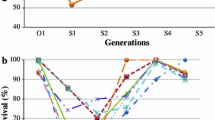Summary
Plant growth habit (type) plays a major determining role in the acceptance of a dry bean cultivar by commercial growers. Under the threat of wet fall conditions in the midwestern U.S., growers show a preference for upright plant types-I and II over the more prostrate type-III growth habit of commercial pinto cultivars. The prostrate habit creates considerably more risk of harvest losses and potential of white mold (Sclerotinia sclerotiorum) development during a wet growing season.
The breeding strategy being utilized to develop better adapted pinto bean cultivars for the humid midwest is based on the concept of ideotype breeding which has been successfully applied to small seeded navy and black beans. A system of phenotypic recurrent selection using S1 selection is being followed in order to recombine desirable traits from two diverse germplasm pools. One germplasm pool possesses the desirable architectural plant form and disease resistance traits of the small-seeded types while the medium-seeded germplasm source possesses the desirable seed size, shape and color characteristics of the pinto class. Since a repulsion phase linkage appears to exist between type-II architecture (architype) and medium seed size (40 g/100 seeds), recurrent selection is shown to be the most effective procedure for breaking up undesirable linkage groups and for increasing the frequency of desirable genes, thus enhancing the chance for the desirable genetic recombinations to occur.
Similar content being viewed by others
References
AdamsM. W., 1973. Plant architecture and physiological efficiency. In: Potentials of field beans and other food legumes in Latin America. Centro Internacional de Agricultura Tropical, Cali, Colombia. p. 226–278.
AdamsM. W., 1982. Plant architecture and yield breeding inPhaseolus vulgaris. Iowa State J. Res. 56: 225–254.
BeaverJ. S., C. V.Paniagua, D. P.Coyne & G. F.Freytag, 1985. Yield stability of dry bean genotypes in the Dominican Republic. Crop Sci. 25: 923–926.
BeaverJ. S. & R. R.Johnson, 1981. Yield stability of determinate and indeterminate soybeans adapted to the Northern United States. Crop Sci. 21: 449–454.
BladB. L., J. R.Steadman & A.Weiss, 1978. Canopy structure and irrigation influence white mold disease and microclimate of dry edible beans. Phytopathology 68: 1431–1437.
CoyneD. P., 1968. Correlation, heritability and selection of yield components in field beans,Phaseolus vulgaris L. Proc. Am. Soc. Hort. Sci. 93: 388–396.
CoyneD. P., 1980. Modification of plant architecture and crop yield by breeding. HortScience 15: 224–247.
FehrW. R. & L. B.Ortiz, 1975. Recurrent selection for yield in soybeans. J. Agr. Univ. P. R. 9: 222–232.
GeptsP. & F. A.Bliss, 1985. F1 hybrid weakness in the common bean. J. Hered. 76: 447–450.
GhaderiA., M. W.Adams & A. W.Saettler, 1982. Environmental response patterns in commercial classes of common bean (Phaseolus vulgaris L.) Theor. Appl. Genet. 63: 17–22.
HansonW. D., 1959. The breakup of initial linkage blokcs under selected mating systems. Genetics 44: 857–868.
Kelly, J. D., M. W. Adams & G. V. Varner, in preparation. Yield stability of determinate and indeterminate dry bean cultivars.
KellyJ. D., M. W.Adams, A. W.Saettler, G. L.Hosfield & A.Ghaderi, 1984. Registration of C-20 navy bean. Crop Sci. 24: 822.
MatherK. (Ed.), 1973. Genetical structure of populations. Chapman & Hall Publ. London. 197 pp.
MottoM., G. P.Soressi & F.Salamini, 1978. Seed size inheritance in a cross between wild and cultivated common beans (Phaseolus vulgaris L.) Genetica 49: 31–36.
SinghS. P. & J. A.Gutierrez, 1984. Geographical distribution of the DL1 and DL2 genes causing hybrid dwarfism inPhaseolus vulgaris L., their association with seed size, and their significance to breeding. Euphytica 33: 337–345.
SinghS. P., 1982. A key for identification of different growth habits ofPhaseolus vulgaris L. Ann. Rept. Bean Impr. Coop. (New York). 25: 92–95.
SullivanJ. G. & F. A.Bliss, 1983. Recurrent mass selection for increased seed yield and seed protein percentage in the common bean (Phaseolus vulgaris L.) using a selection index. J. Amer. Soc. Hort. Sci. 108: 42–46.
Author information
Authors and Affiliations
Additional information
Journal Article No. 11667 of the Michigan Agricultural Experiment Station.
Rights and permissions
About this article
Cite this article
Kelly, J.D., Adams, M.W. Phenotypic recurrent selection in ideotype breeding of pinto beans. Euphytica 36, 69–80 (1987). https://doi.org/10.1007/BF00730649
Received:
Issue Date:
DOI: https://doi.org/10.1007/BF00730649




